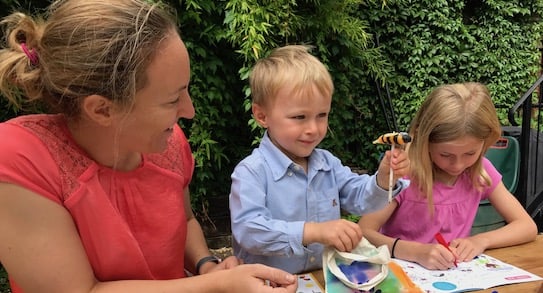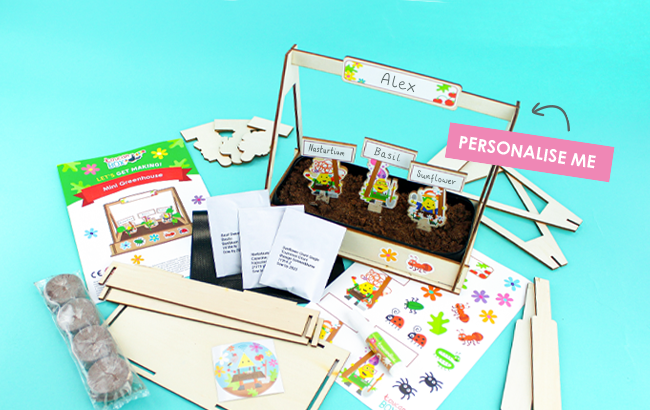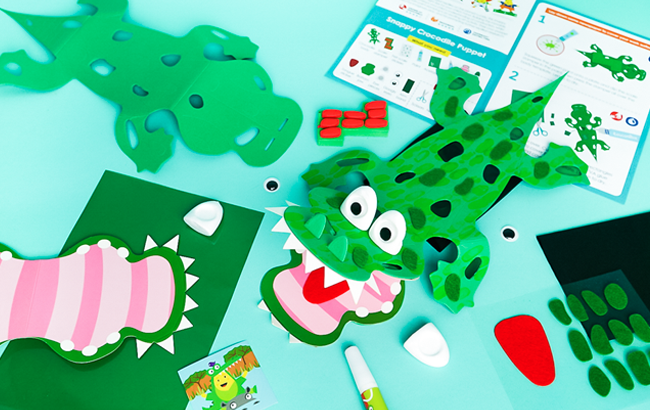How Art can help children with Language Development
 Talking about art while crafting with your child or toddler not only teaches them nouns and verbs. It also helps them learn to describe colours, materials and textures. Craft activities encourage
the speech and language development in young children.
Talking about art while crafting with your child or toddler not only teaches them nouns and verbs. It also helps them learn to describe colours, materials and textures. Craft activities encourage
the speech and language development in young children.
Survey finds that the role of art in language learning is underestimated
In a recent survey with 500 families, toucanBox found that parents underestimate the role of art in language learning: Less than half of parents know that arts and crafts can help with language development in young children. Even for parents and carers the verbal interaction with a child while crafting does not seem to count so much. But this is an underestimation: Because the child is doing something with the hands and tries to talks about it with an adult, art activities are very good for language development. Not only in combination with sad circumstances like traumas, children express their feelings quite often when practising communication trough arts and crafts.
Children often start school with insufficient communication skills
This is particularly important when you hear that the head of Ofsted, Amanda Spielman, warned that children are starting school unable to speak properly. "We now have a situation where, aged four, some children have less than a third of the English vocabulary of their peers. These children arrive at school without the words they need to communicate properly. Just imagine the disadvantage they face, right from the start. Unable to follow what's going on. Unable to keep up with their classmates. Unable to reach their potential."
Supporting this, a poll conducted by Oxford University Press with 473 primary school teachers, and published in TES, reported that almost half of Year 1 pupils had a word gap sufficient to negatively affect their learning. Teachers reported that this also affected pupils’ self esteem, mental health and wider life chances.
How arts and language development are connected: Improving communication through arts and crafts in young learners
“Although a lot of discussion correctly emphasises the need for parents to read bedtime stories or nursery rhymes with their children as a way to decrease the word gap, parents should also be made aware that there are other fun and engaging activities children can do to expand their vocabulary and express themselves in meaningful ways”, explains Sara Co-founder and Head of Product at toucanBox, who has over 15 years of Montessori teaching experience.
“Young children love to make art. Whether it’s paint, crayons, glue or glitter, they instinctively express themselves, and make sense of their world, through the process of creating art. It also teaches children to use words about colours, shapes, textures and verbs,” she continues.
“Children learn to use their language to describe their feelings about the art they are making. When children engage in art and crafts at home, parents and carers have an opportunity to talk about it. In a careful way the adults can correct mistakes and help them find good expressions of what they want to say. The problem is that most adults don’t know how to start a good conversation about the art activity or creation. Instead of asking children, ‘What is that?’ they should ask why they have used certain colours or shapes, and what inspired them.”
James, a former primary school teacher and currently the Editor of toucanBox’s STEAM magazine, highlights that “By following directions in making arts and crafts it also helps to introduce children to prepositions (glue the orange foam onto the black paper), comparatives (make the rectangle bigger than the square), and imperatives (do cut the foam squares into triangles). Furthermore they learn to use verbs such as wonder and ponder…. As they talk about what might happen next.”
Some evidence of how art was transformed into language development activities
This is supported by evidence parents gave in toucanBox’s research study when asked what they had seen their child learning in the process. We received many are only some of the many comments related to language stimulation in our survey. Here are only some of the comments that were expressed by parents.
“My niece’s speech and language has improved as we talk about the theme we are making”, said one respondent.
“When making the pirate themed box, it was an opportunity to discuss the effect that modern day pirates have on merchant shipping”, said another parent.
“Learning parts of the flower when making some”
“She starting talking about adding new designs to her project”
“We read the information in the box about that particular item”
Encouraging arts and crafts activities for speech and language development despite hectic lifestyles
Unsurprisingly, despite the educational benefits of making arts and crafts, toucanBox’s own research with 500 parents revealed that 1 in 4 children do not make arts and crafts as often as they would like. The three main reasons cited for this are that parents do not have the materials needed to hand, they don’t know how to or don’t have the time to get involved due to work commitments or having to look after younger siblings. Also children are too busy with extracurricular activities. “Work commitments limit family time”, said a respondent.
“By making it as convenient as possible for parents, they are more encouraged to bring art and crafts into their home”, comments Virginie Charles Dear, Co-founder and CEO of toucanBox. “That is the reason why we started toucanBox many years ago. We saw that by addressing a lot of the inhibitors parents and carers face, we could make a real difference to families’ lives. By having activity kits delivered to the home every fortnight, containing all the materials they need along with illustrated instructions children can follow easily themselves, parents find very little gets in the way of a child making a craft. Moreover, by reading the magazine together, parents and children are engaged in talking about the world around them. This is why we have found that over 90% of toucanBox subscribers confirmed their children engage in arts and crafts more often since they started their subscription with toucanBox.”
The same survey also found that toucanBox helps families to bond as almost 90% of parents and carers said a subscription to toucanBox encouraged them to participate in arts and crafts with their children more often. The top three benefits that parents cited are that:
- They can help children learn new things
- They are making memories together
- And they have quality time together they otherwise wouldn’t have.
“Teaching language is not all about sitting at a desk with worksheets or learning from flashcards. Through arts and crafts children do not even know they are learning as they are simply having fun. Achieving this is our primary focus when we create and develop new crafts”, says Jenny, Product Designer at toucanBox.
toucanBox is an award-winning subscription service delivering activity kits to kids age 3-8. Each box is built by educational experts to help develop key skills through hands-on play. All the materials, instructions and inspiration are included to make getting creative easy, stress-free and really good fun. Sara Barokas (Montessori teacher) is available for interviews. For press enquiries email [email protected].
Not tried toucanBox yet?
Want craft projects, with all the materials you'll need, delivered straight to your door? Sign up today and save 50% on your first box!
Not ready to commit? Subscribe to our fun-filled weekly newsletter, jam packed with craft ideas, recipes, fun activities and more!


